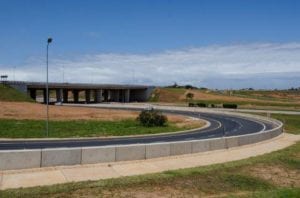The South African National Roads Agency SOC Limited (SANRAL) initiated the Ballito Interchange project, in Durban, originally to improve the capacity of the interchange, which became highly congested at peak times.
The initial plan was to add a single loop ramp to accommodate east-to-north turning movement. However, a detailed traffic study carried out by SMEC South Africa indicated that this solution would at best be a stopgap measure. In addition, construction of a new loop ramp would necessitate lengthening the existing bridge, an undertaking that would make it extremely difficult to accommodate existing traffic. “Taking future growth into account, we also found that a single loop ramp would not suffice,” comments Dawie Erasmus, Functional Head: Roads and Highways at SMEC South Africa. “There were other capacity considerations in keeping the traffic flowing,” he adds. “That led us to consider the possibility of a new bridge that could accommodate double loop ramps underneath it, as well as the additional lanes on the cross road on top. This could be constructed with the traffic utilising the existing bridge,” points out Erasmus. Certain deficiencies in the existing bridge deck were also identified. These supported the building of a new bridge.A practical and cost effective solution
Such detailed analysis of the existing infrastructure, in tandem with the client’s specific requirements, resulted in SMEC South Africa coming up with the most practical and cost-effective solution possible. “We proposed building a partial clover leaf interchange with two loop ramps, but shifted slightly south so that these loops could be fitted in,” highlights Erasmus.This was necessitated by the fact that quite severe land topography constraints and development in the eastern quadrant limited what could be done.
SMEC South Africa then embarked on extensive opinion discussions with the client, with the end result being almost a total redesign and rebuild of the Ballito Interchange. The construction phase of the project lasted 18 months, with Stefanutti & Stocks Civils KZN appointed as the main contractor. “We were not only responsible for the design, but also monitored the construction period,” adds Erasmus. SMEC South Africa had a Resident Engineer and an Assistant Resident Engineer on-site, in addition to a Contracts Manager overseeing the project. The project has been completed successfully, with SANRAL reportedly very happy with the end result. “We are certainly pleased with delivering a high-quality project,” concludes Erasmus.







